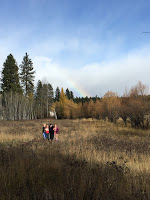Over the past few years, taking learning outdoors has become so high on my "Must Do" list for teaching. I have a hard time remembering why I didn't take my students outside earlier on, or how I taught particular topics without being outdoors. With many other teachers now eager to start taking their classes outside, I find that the question I am most often asked in conversations and during presentations is, "but what do students DO outside?". During my observations this past week, I came up with so many answers to this common question!
They squeal with joy, and connect deeply with their local surroundings. While making connections with the land, they also have meaningful conversations with others.
They create a plan, discuss the plan, and collect materials to execute the plan. Here, students were collecting materials they wanted to use for nature art projects, inspired by Andy Goldsworthy.
They share ideas, work as a team, and compromise.
They learn to work independently and to think for themselves. They try out new ideas and beam with pride when something they try works.
They work together as a team, calling out, "can you please help me with..." and "I'm going to need someone over here".
They learn to adjust plans as they go along, acknowledging the changes and the reasons behind each change.
They present their ideas to others, and answer questions about how they have used natural materials to create art.
They learn to use materials that are already on the ground, and care for the plants and trees around them.
They use their observational skills and their keen sense for wonder to spot nature's miracles... like rainbows!
They offer to help when they see that their friends need an extra pair of hands. They ask questions, such as, "where are we putting this?", "what else are we going to need?" and "who else can help us?". They willingly lend a helping hand, and are keenly aware of the impact that just one person can have.
They are determined and focused on a task. They experiment with many ideas, and use trial and error to figure out their next steps.
They take calculated risks, and strengthen new relationships in the process.
They help others with a project without being asked, moving easily between working in a large group, working a small group, and working on their own.
They feel empowered by adults who adjust their agendas to allow for student interests to guide learning.
They are intuitive in the way that they watch others to see when someone needs help.
They inform others about how they can help bring a creation to life.
They turn into statues.
They develop problem solving skills by collaborating with children they don't typically play with.
They ask questions about what others are doing, and warm hearts by saying things like, "what have you been up to? I was looking all over for you".
They look closely, carefully, full of wonder and awe. They use their imagination, spinning grand adventures from one simple hole.
























No comments:
Post a Comment